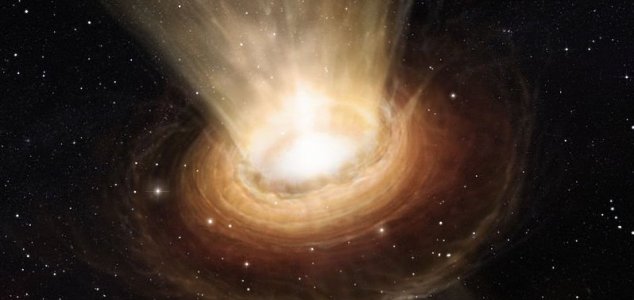Space & Astronomy
December 13, 2016 · 18 comments
18 comments

The star wouldn't have stood a chance. Image Credit: CC BY 4.0 ESO/M. Kornmesser
As it turned out however, the light had actually come from a star that had wandered in to the path of a large spinning black hole and was torn to pieces by its extreme gravitational forces.
The black hole in question is thought to be over 100 million times the mass of the Sun.
When the star got too close it was ripped apart by what is known as a "tidal disruption event" before being "spaghettified" - a term used to describe what happens to matter under such conditions.
Some of the matter was converted in to light - thus explaining the bright light originally observed.
"This gave the event the appearance of a very bright supernova explosion, even though the star would not have become a supernova on its own as it did not have enough mass," the team wrote.
Source: BBC News | Comments (18)
Black hole is observed 'swallowing' a star
By T.K. RandallDecember 13, 2016 ·
 18 comments
18 comments
The star wouldn't have stood a chance. Image Credit: CC BY 4.0 ESO/M. Kornmesser
Astronomers at Queen's University, Belfast have helped to discover an extremely rare celestial event.
The research had started out as an effort to identity the nature and origins of an "extraordinarily brilliant" light in the distant universe that US scientists had believed to be an exploding star.As it turned out however, the light had actually come from a star that had wandered in to the path of a large spinning black hole and was torn to pieces by its extreme gravitational forces.
The black hole in question is thought to be over 100 million times the mass of the Sun.
Some of the matter was converted in to light - thus explaining the bright light originally observed.
"This gave the event the appearance of a very bright supernova explosion, even though the star would not have become a supernova on its own as it did not have enough mass," the team wrote.
Source: BBC News | Comments (18)

The Unexplained Mysteries
Book of Weird News
AVAILABLE NOW
Take a walk on the weird side with this compilation of some of the weirdest stories ever to grace the pages of a newspaper.
Click here to learn more

Support us on Patreon
BONUS CONTENTFor less than the cost of a cup of coffee, you can gain access to a wide range of exclusive perks including our popular 'Lost Ghost Stories' series.
Click here to learn more
Ancient Mysteries and Alternative History
Conspiracies and Secret Societies
Science and Technology
Philosophy and Psychology
Total Posts: 7,768,366 Topics: 325,021 Members: 203,768
Not a member yet ? Click here to join - registration is free and only takes a moment!
Not a member yet ? Click here to join - registration is free and only takes a moment!

































Please Login or Register to post a comment.